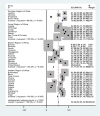Determinants of postnatal care utilization in sub-Saharan Africa: a meta and multilevel analysis of data from 36 sub-Saharan countries
- PMID: 33246475
- PMCID: PMC7693498
- DOI: 10.1186/s13052-020-00944-y
Determinants of postnatal care utilization in sub-Saharan Africa: a meta and multilevel analysis of data from 36 sub-Saharan countries
Abstract
Introduction: Globally, over 65% of maternal deaths occur during the first 42 days of postpartum while the same proportion of neonatal deaths occur during the first 7 days of life. In sab- Saharan Africa, 4.7 million mothers, newborns, and children die on annual basis. As to our knowledge, there is no study on postnatal care utilization that incorporates all sub-Saharan Africa countries that had DHS data. Therefore, this study aimed at identifying pooled magnitude and determinants of postnatal care utilization in sub-Saharan Africa.
Method: A population-based cross-sectional study from the most recent Demographic and Health Surveys data from the period of 2006 to 2018 of 36 SSA countries were used. A total weighted sample of 286,255 reproductive-age women who gave birth 5 years preceding the survey were included in the study. A meta-analysis of DHS data of each Sub-Saharan countries was conducted to generate pooled magnitude and a forest plot was used to present it. A multilevel logistic regression model was fitted to identify determinants of postnatal care utilization. The AOR (Adjusted Odds Ratio) with their 95% CI and p-value ≤0.05 was used to declare that determinates associated with postnatal care utilization.
Result: The pooled magnitude of postnatal care utilization in sub-Saharan Africa countries was 52.48% [95% CI: 52.33, 52.63], with the highest postnatal care utilization in the Central Region of Africa (73.51%) and the low postnatal care utilization in Eastern Regions of Africa (31.71%). In the multilevel logistic regression model region, residence, age group, maternal education, maternal occupation, media exposure, ANC visit, place of delivery, and accessing health care were determinants of postnatal care utilization in Sub-Saharan Africa.
Conclusion: The coverage of postnatal care service utilization was low with high disparities among the region. Being in rural residence, young age group, low education level, had no occupation, not exposed to media, a big problem to access health care, not had ANC visit, and home delivery was associated with low postnatal care service utilization. This study evidenced that there is a wide gap in postnatal care utilization between SSA countries. Special attention is required to improve health accessibility, utilization, and quality of maternal health services to increase postnatal care service utilization in the region.
Keywords: Determinants; Multilevel; Postnatal care; Sub-Saharan Africa.
Conflict of interest statement
Authors declare that they have no conflict of interest.
Figures
Similar articles
-
Non-utilization of selected newborn postnatal care and associated factors among postpartum women in East Africa: a multilevel mixed-effect analysis using the most recent DHS data 2016-2023.BMC Pregnancy Childbirth. 2025 Apr 23;25(1):470. doi: 10.1186/s12884-025-07594-0. BMC Pregnancy Childbirth. 2025. PMID: 40269799 Free PMC article.
-
Determinants of completing recommended antenatal care utilization in sub-Saharan from 2006 to 2018: evidence from 36 countries using Demographic and Health Surveys.BMC Pregnancy Childbirth. 2021 Mar 6;21(1):192. doi: 10.1186/s12884-021-03669-w. BMC Pregnancy Childbirth. 2021. PMID: 33676440 Free PMC article.
-
Only three out of ten women received adequate postnatal care in sub-Saharan Africa: evidence from 20 countries demographic and health surveys (2015-2022).BMC Pregnancy Childbirth. 2025 Feb 11;25(1):138. doi: 10.1186/s12884-025-07276-x. BMC Pregnancy Childbirth. 2025. PMID: 39934721 Free PMC article.
-
Interventions to increase facility births and provision of postpartum care in sub-Saharan Africa: a scoping review.Reprod Health. 2021 Jan 21;18(1):16. doi: 10.1186/s12978-021-01072-4. Reprod Health. 2021. PMID: 33478542 Free PMC article.
-
Utilization of birth companionship and its associated factors among laboring mothers during facilities birth in sub-Saharan Africa. Systematic review and meta-analysis.SAGE Open Med. 2024 Sep 29;12:20503121241272572. doi: 10.1177/20503121241272572. eCollection 2024. SAGE Open Med. 2024. PMID: 39372911 Free PMC article. Review.
Cited by
-
Adolescent pregnancies and adherence to puerperal consultation.Rev Lat Am Enfermagem. 2022 Oct 3;30(spe):e3703. doi: 10.1590/1518-8345.6269.3703. eCollection 2022. Rev Lat Am Enfermagem. 2022. PMID: 36197392 Free PMC article.
-
Determinants of accessing healthcare in Sub-Saharan Africa: a mixed-effect analysis of recent Demographic and Health Surveys from 36 countries.BMJ Open. 2022 Jan 31;12(1):e054397. doi: 10.1136/bmjopen-2021-054397. BMJ Open. 2022. PMID: 35105635 Free PMC article.
-
Non-utilization of selected newborn postnatal care and associated factors among postpartum women in East Africa: a multilevel mixed-effect analysis using the most recent DHS data 2016-2023.BMC Pregnancy Childbirth. 2025 Apr 23;25(1):470. doi: 10.1186/s12884-025-07594-0. BMC Pregnancy Childbirth. 2025. PMID: 40269799 Free PMC article.
-
Maternal Perspectives on and Preferences for an Enhanced Neonatal Jaundice Education Program: An Evaluation Using the Consolidated Framework for Implementation Research.Patient Prefer Adherence. 2024 Oct 30;18:2187-2202. doi: 10.2147/PPA.S486921. eCollection 2024. Patient Prefer Adherence. 2024. PMID: 39493598 Free PMC article.
-
The epidemiology and risk factors for postnatal complications among postpartum women and newborns in southwestern Uganda: A prospective cohort study.PLOS Glob Public Health. 2024 Aug 7;4(8):e0003458. doi: 10.1371/journal.pgph.0003458. eCollection 2024. PLOS Glob Public Health. 2024. PMID: 39110697 Free PMC article.
References
Publication types
MeSH terms
LinkOut - more resources
Full Text Sources
Medical
Research Materials
Miscellaneous


